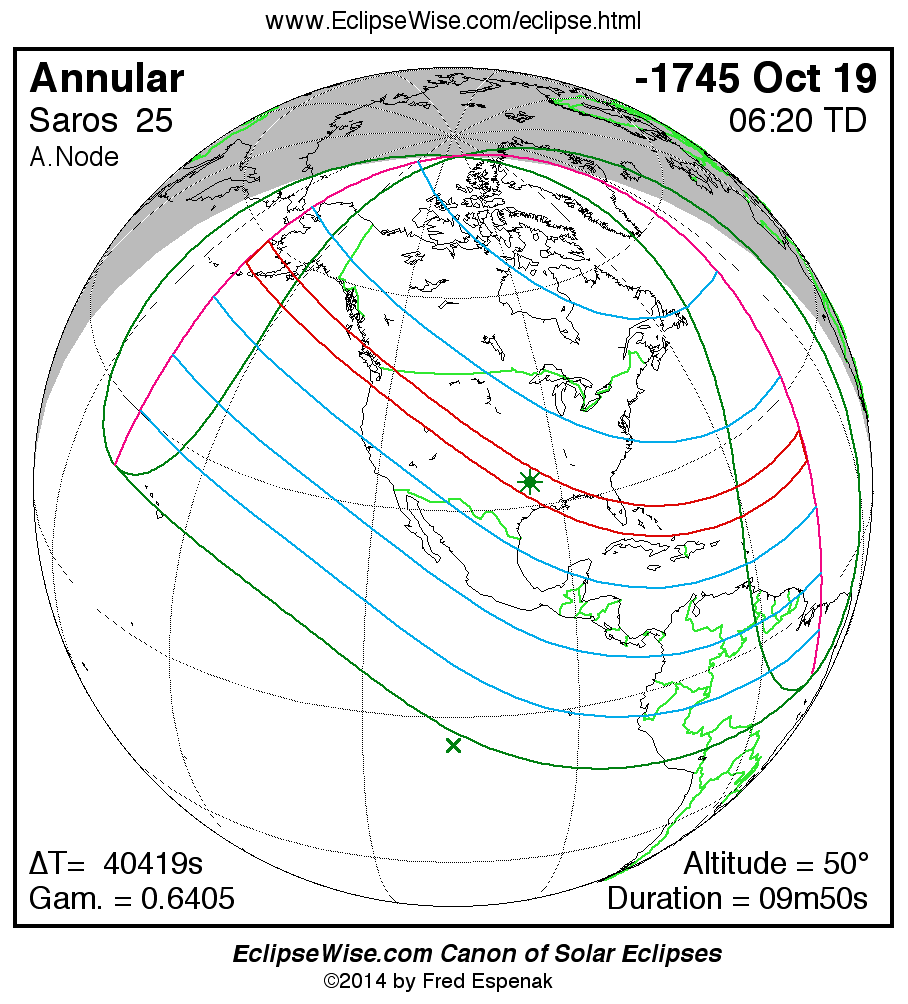Solar Eclipse Prime Page
Annular Solar Eclipse of -1745 Oct 20 (1746 Oct 20 BCE)
Fred Espenak
Introduction
The Annular Solar Eclipse of -1745 Oct 20 (1746 Oct 20 BCE) is visible from the geographic regions shown on the map to the right. Click on the map to enlarge it. For an explanation of the features appearing in the map, see Key to Solar Eclipse Maps.
The instant of greatest eclipse takes place on -1745 Oct 20 at 06:19:58 TD (19:06:23 UT1). This is 1.3 days after the Moon reaches apogee. During the eclipse, the Sun is in the constellation Scorpius. The synodic month in which the eclipse takes place has a Brown Lunation Number of -45357.
The eclipse belongs to Saros 25 and is number 17 of 71 eclipses in the series. All eclipses in this series occur at the Moon’s ascending node. The Moon moves southward with respect to the node with each succeeding eclipse in the series and gamma decreases.
The solar eclipse of -1745 Oct 20 is an exceptionally long annular eclipse with a duration at greatest eclipse of 09m50s. It has an eclipse magnitude of 0.9160.
The annular solar eclipse of -1745 Oct 20 is preceded two weeks earlier by a partial lunar eclipse on -1745 Oct 05.
These eclipses all take place during a single eclipse season.
The eclipse predictions are given in both Terrestrial Dynamical Time (TD) and Universal Time (UT1). The parameter ΔT is used to convert between these two times (i.e., UT1 = TD - ΔT). ΔT has a value of 40414.4 seconds for this eclipse. The uncertainty in ΔT is 2727.5 seconds corresponding to a standard error in longitude of the eclipse path of ± 11.40°.
The following links provide maps and data for the eclipse.
- Orthographic Map: Annular Solar Eclipse of -1745 Oct 20 - global map of eclipse visibility
- Google Map: Annular Solar Eclipse of -1745 Oct 20 - interactive map of the eclipse path
- Path Table: Annular Solar Eclipse of -1745 Oct 20 - coordinates of the central line and path limits
- Circumstances Table: Annular Solar Eclipse of -1745 Oct 20 - eclipse times for hundreds of cities
- Saros 25 Table - data for all eclipses in the Saros series
The tables below contain detailed predictions and additional information on the Annular Solar Eclipse of -1745 Oct 20 .

